Think back on a few of the times you’ve done a little negotiating in your personal life. Before you made an offer on a used car, you probably looked up the value on Kelley Blue Book. Before you asked for a break on rent, you probably built a little rapport with your landlord.

Even before you asked your roommate to take out the trash, you might’ve picked a time where you’d been especially helpful. If you’ve ever found yourself doing any of these things, congratulations. You’re already doing the most important part of negotiation. You took the time to review the situation.
This article teaches you how to do that in a business negotiation, so you can figure out the best way forward with the other party. Because it’s like Marcus Lemonis says, “The key to business… is being able to relate to people.”
The Importance of Surveying the Situation
When you buy a used couch online, you’re usually just going back and forth on price. But most business deals are way more complex than that. You both want multiple things and would probably be happy with a ton of different outcomes.That’s great news because it means there are a ton of paths leading to some version of a win-win. Surveying the situation helps reveal those paths. And the more paths you uncover, the greater the odds of finding one that works for both parties.
Leigh Thompson, a professor at Northwestern, estimates that 80% of managers fail to reach a win-win and leave value on the table. But that doesn’t have to happen to you. Surveying the situation increases the pool of information, the range of potential solutions, and helps you unlock the value that’s just around the corner.
The Benefits of Surveying The Situation
The biggest reason you review the situation is that knowledge is power when you’re negotiating. It arms you with everything you need to give a little, but also get a little. Remember, you’re trying to arrive at a mutual agreement. So, gaining an intimate knowledge of the landscape helps you dial in on the overlap that gets this thing done. You see that on display when Marcus visited a company in California that makes outdoor furniture. He loved their gazebos, but was bumped a little bit by all the organizational chaos and their leadership style. That didn’t mean it was time to walk away, though. It meant it was time to review the situation and see if they could work something out. He did a little listening and realized they were interested in financing, but also mentorship. So, Marcus decided to do a little mentoring. He gave them some leadership tips, ideas for improving morale, and a template for improving margins. Then he told them that if they could incorporate some of those tips within the next three weeks, he’d be comfortable enough to follow up with the second thing they wanted: financing. They struck a deal, all because Marcus was able to review the situation and find that win-win.
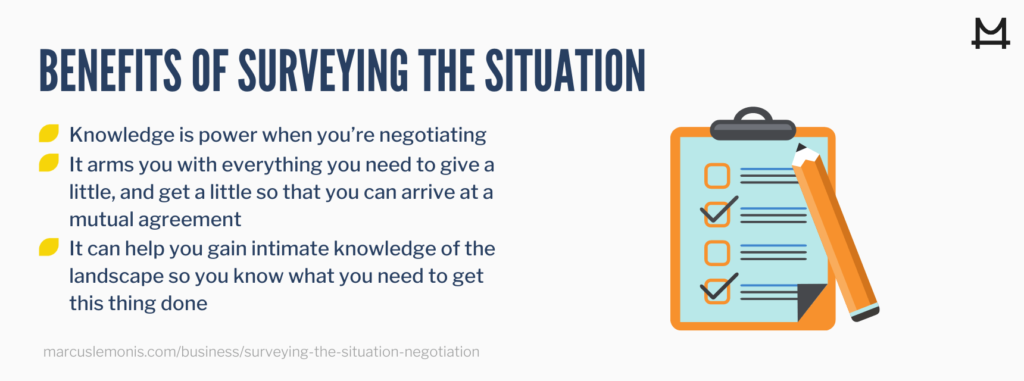

How to Review the Situation
Step 1 - Do Your Homework
The most successful negotiations begin with a pretty thorough preparation phase. One great thing to identify is the zone of possible agreement, sometimes called your Z.O.P.A. This means you’ve carefully identified your best-case scenario, as well as less ideal, but still acceptable outcomes. Then you take a crack at doing the same for whoever you’re negotiating with so you get an idea of what they’ll ask for and how you’ll respond. You’ll also want to identify your best alternative to a negotiated agreement, often called your B.A.T.N.A. In other words, make sure you know all your options. This means a healthy dose of Marcus’ “Know your numbers.” If you’re hoping to buy 10,000 chairs for your event planning company, what other places can you approach about this? Are there a ton? Or is there only one other place, they’re in Tokyo, and shipping costs are crazy. Identifying your next best option teaches you a lot about how much you’re willing to give on certain things. FOX did a great job of that when they struck a deal with Disney in the example below.

When Disney was first looking into buying FOX, they came in with an offer of around $52 billion. But FOX wanted to get a sense for their options, so they put out some feelers. They ended up getting an offer from another party, Comcast, for $65 billion. So, when they sat back down with Disney, they were armed with an important piece of information; they knew their next best option to a deal with Disney, and further, was even better. This drove up the price and Disney raised their offer by almost $20 billion. That was a direct result of doing their homework and understanding the landscape. Now, think about your next deal. Is there a way that surveying the situation can drive up the price that you’re willing to land on?
Step 2 - Everyone Communicates Their Position
This is when your talks have officially begun. You’ll want to pay special attention to three areas of communication, because they’re all equally important.

- Explain Your Position – Let’s say you run a small forensic accounting firm and you’re offering a new hire an important role. You’re willing to pay above market and your benefits are great. But you’re very clear about the fact that the pay is in line with expectations. Everyone works a lot, travels a ton, and is excited about really pushing themselves. You’ve done a great job explaining what you’re offering and what you expect in return.
-
- Actively Listen to Their Position – They seem really excited, but are also weighing another offer. They mention living about an hour away from your office, which they aren’t too worried about, but you can tell it’s a factor. You’re writing things down and really making them feel heard. You don’t want to chase them, but are surveying the situation, reading their body language, and can tell you both want to make this work.
- Clarifying – You paraphrase their position to make sure you understand them correctly, and by doing that, uncover an important misunderstanding. You have two offices and their role would actually be in a suburb where the rent is much cheaper. That means their money would go further and their commute would be drastically less. Is that enough to reach an agreement? Would another $1,000 in salary do the trick? How about a work-from-home day? You don’t need to figure that out until you reach the next phase where you’re actually problem solving. But by communicating, you already see plenty of ways for this to come together.
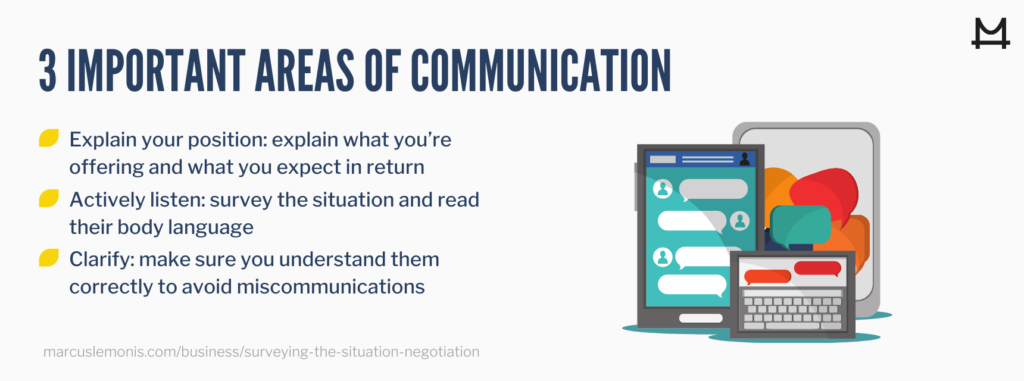
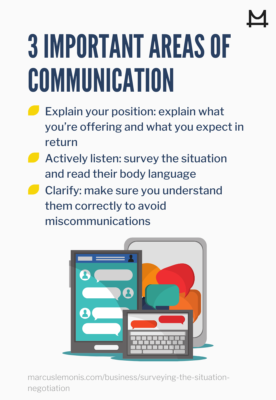
Step 3 - You Problem Solve
Do you remember Marcus’ “If you don’t evolve, you die?” Think of the problem-solving phase exactly like that. When you come in with a mindset of flexibility, you give yourself the wiggle room you need to keep the deal alive. We saw this in the AT&T merger with Time Warner. The government initially tried to block the merger because they thought it would mean less choices for consumers and higher prices. But AT&T and Time Warner did a great job surveying the situation. They realized the Justice Department didn’t totally understand the TV industry, so they explained that they weren’t actually direct competitors. The whole point of the merger was to merge Time Warner’s content with AT&T’s distribution so they could contend with streaming services like Hulu and Netflix. This would actually increase competition. So, the $81 billion merger ended up going through because of a stellar job clarifying and problem solving. If you review the situation carefully in your own negotiations, will you spot a way to hurdle over obstacles?
Step 4 - You Reach an Agreement
You always hear Marcus say, “When you shake someone’s hand it’s gotta mean something.” So, make sure your agreement holds both parties accountable. Are there certain deadlines you need to put in writing? What does the dismount look like if someone isn’t holding up their end of the bargain? Do they need oversight so you can keep surveying the situation even after you sign the deal?

Your agreement should definitely create this sort of accountability, but ironically, the way you structure it can also increase flexibility. Let’s say you’re an inch away from agreeing on price. Would it help finalize things if they didn’t have to pay anything for 60 days? What if you stretched 12 months of payments over 24 months? Getting a little creative in your deal structure might be that little extra nudge that gets this over the finish line. Lastly, if you can’t make a deal, don’t nuke the relationship. You can always agree not to agree. You might not be on the same page today, but things change. Life works in mysterious ways. The deal of a lifetime might be just around the corner.

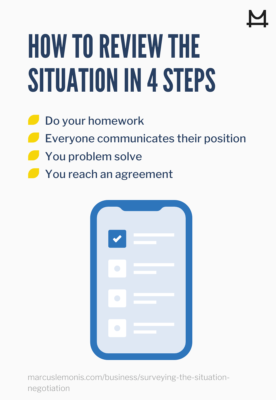
3 Tips on Surveying the Situation
1. Be Aware of Anchoring
There’s a great book called “Thinking, Fast and Slow” by psychologist Daniel Kahneman in which he describes a negotiation technique called “anchoring.” The gist is that whoever says the first number subconsciously informs where you’ll land. For example, let’s say someone walks into your apartment. They like your rug and say, “Hey, would you ever consider selling that thing?” If you mention any number in your response, you’re creating an expectation.

If you say, “Sure, I wouldn’t need to get $12,000 for it or anything crazy, but I’d be open to talking it out.” The fact that you even mentioned $12,000 in passing immediately casts this rug as a high-ticket item. Now, imagine you said, “I couldn’t quite let it go for $25, but did you have a number in mind?” It’s the same rug, but subconsciously, the mention of $25 pushes your discussions way lower than the prestige item in the first scenario. When you’re surveying the situation, ask yourself if any anchoring contaminated your thought process. That way, you can assign a fair value to the transaction without the influence of arbitrary factors.
2. Put a Time Frame on Your Offer
You’ve probably seen those late-night commercials that say, “Act now while supplies last!” That’s a familiar refrain because it’s rooted in human psychology. Urgency drives action. People don’t want to miss out. You can bring this concept to your negotiations by putting a time frame on your offer. You don’t want to put anyone on the spot, but it’s okay to throw a reasonable deadline out there. If you don’t, you give them an opportunity to go out, play the field, and shop for a better deal. A deadline also keeps them engaged so you can continue to review the situation. Have you ever texted someone and three days later you still haven’t heard back? You start to wonder if they’ve lost interest. In business, that’s actually a negotiating tactic. People can slow play your offer to feign disinterest and hope you’ll come back with something better. So, make sure you put a time limit on your offer to keep you both moving towards victory.
3. Utilize Contingency Deals
This allows you to review the situation during the execution phase. It’s an especially great tool if you’re dealing with a huge unknown. Let’s say you own a regional restaurant chain and are hoping to open a new location just in time for summer. You meet with a few contractors you like, but really hit it off with one in particular.

You explain that you’re right by the ocean, get a lot of tourists, and absolutely have to have this done by June or you’ll miss out on a ton of money. The contractor swears they can get it done on time, but you’re not so sure. They’ve never done a job quite this fast before. So, you strike a contingency deal. You agree to pay $100,000 if it’s done by June, but if they’re late, they knock some money off the final price. Everyone leaves happy. You’re protected if the project hits any snags and they feel like they’re being taken care of financially, all because you’re able to review the situation as it unfolds.

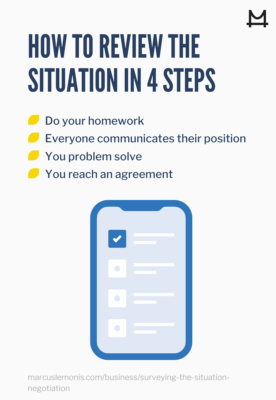
Did you ever ask your mom if you could stay out late? You probably wanted to see if she was in a good mood first. You wanted to make sure all your chores were done. You even looked ahead to the following morning to make sure you took out the trash bins in advance. All of this context was the backdrop for negotiating your curfew. Your ability to speak to all of those factors meant the difference between staying out late and getting stuck at home. That’s what it is to review the situation when you’re negotiating business deals. When you know all the background and see all the angles, your company finds those win-wins – and gets to stay out until midnight.
- What does your current negotiation preparation look like?
- What tips from the above can you leverage for your next negotiation?
Gordon, M. & Arbel, T. (2019, February 26). Federal appeals court blesses AT&T’s $81 billion merger with Time Warner.
Retrieved from https://www.chicagotribune.com/business/ct-biz-att-time-warner-merger-cleared-20190226-story.htmlNasher, J. (2018, December 29). Top 10 world changing negotiations of 2018.
Retrieved from https://www.forbes.com/sites/jacknasher/2018/12/29/top-10-negotiations-of-2018/#405363eb2eb2Thompson, L. (2019, November 12). For successful negotiation look beyond your own industry.
Retrieved from https://www.ft.com/content/a0e9597e-ff67-11e9-b7bc-f3fa4e77dd47





